As an Amazon Associate I earn from qualifying purchases.
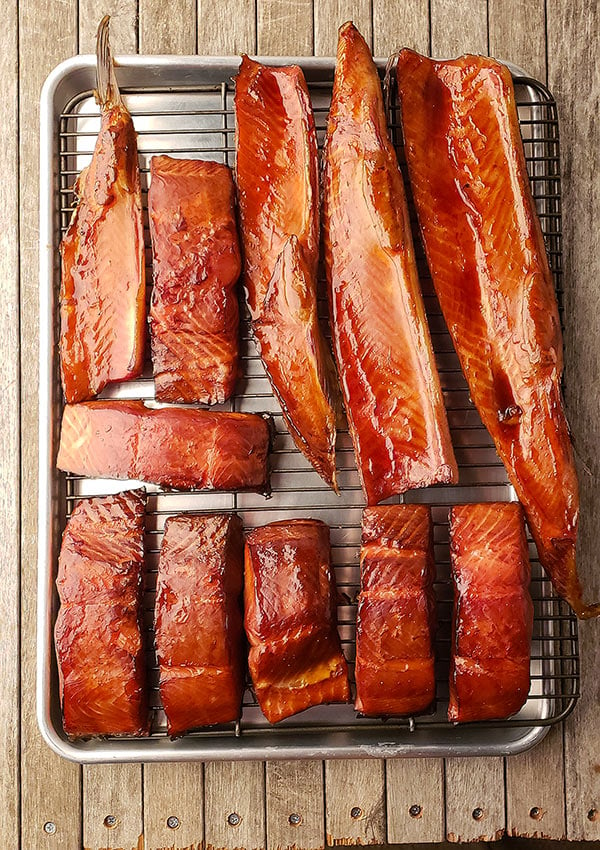
I smoke a lot of salmon, and I am proud of this recipe, although it would be the height of arrogance to say that what I do is the end-all, be-all of salmon smoking recipes. Lots of people smoke their salmon in lots of ways, and many of them are good. But I’ve been smoking fish for many years, and I’ve developed a system that works well.
Keep in mind this is a hot-smoking recipe. Cold smoking, which is the kind of slice-able smoked fish you get in fancy boxes from Scotland is an entirely different thing.
Almost everyone in Salmon Country hot smokes their fish. If you’re unfamiliar with hot-smoked fish, think about those golden smoked whitefish you see in delicatessens; those are hot smoked.
How do you eat it? Well, you can just eat it plain, or you can flake it and make it into a smoked salmon salad, you can pound it with butter and make salmon rillettes, serve it in deviled eggs, tossed with pasta… you get the point.
Here’s what you need to get started:
- A smoker. I’ve uses a Traeger and a Bradley. Both are good. No matter what smoker you use, you will need to be able to a) know your smoking chamber’s temperature, and b) control the heat, at least in a rough sense.
- Wood. The only downside to a Traeger smoker is that you need to use their wood pellets. As a guy who used a Brinkmann wood-fired BBQ for years, fueling it with scraps of almond and other fruit woods, buying wood can be annoying, but you get better precision with this method. I prefer to use alder wood for my salmon, but apple, cherry, oak or maple work fine.
- Salt. Buy a box of kosher salt from the supermarket. Do not use regular table salt, as it contains iodide and anti-caking agents that will give your salmon an “off” flavor. I use Diamond Crystal, which is cut finer than Morton’s.
- Something sweet — salmon love sweet. I prefer to sweeten my smoked salmon with birch syrup; It’s just like maple syrup, only tapped from birch trees instead. Super cool stuff. But maple syrup is just as good. Just use real maple syrup, OK? Not the imitation crap. Honey works, too.
- A large plastic container. Buy the big, flat ones from the supermarket. They stack easily in a normal fridge, so you can have two different brines going. And they clean easily and are pretty cheap.
- A wire rack. You need to rest your brined fish on a rack with plenty of air circulation to form the all-important pellicle (more on that in a bit), and you will use it to rest the smoked fish before storing it.
- A basting brush. You probably already have this in your kitchen, but if not, pick one up. Get the flat kind, like you use to paint detail on window trim.
When you are ready to start, you will need smallish pieces of salmon about 1/4 to 1/2 pound each. Any salmonid fish will work with this recipe. I’ve done it with king salmon, sockeye, coho, and pink salmon, dolly varden, plus kokanee, steelhead and Lahontan trout.
There is no reason it would not work with chum salmon or any other char or trout species. And yes, it works with farmed Atlantic salmon, but I never eat the stuff.
I prefer to smoke salmon with its skin on, but I’ve done it with skinless pieces and it works fine.
Smoked Salmon
Ingredients
- 5 pounds salmon, trout or char
- Birch or maple syrup for basting
BRINE
- 1 quart cool water
- 1/3 cup Diamond Crystal kosher salt, about 2 ounces of any kosher salt
- 1 cup brown sugar
Instructions
- Mix together the brine ingredients and place your fish in a non-reactive container (plastic or glass), cover and put in the refrigerator. This curing process eliminates some of the moisture from the inside of the fish while at the same time infusing it with salt, which will help preserve the salmon.
- You will need to cure your salmon at least 4 hours, even for thin fillets from trout or pink salmon. In my experience, large trout or char, as well as pink, sockeye and silver salmon need 8 hours. A really thick piece of king salmon might need as much as 36 hours in the brine. Never go more than 48 hours, however, or your fish will be too salty. Double the brine if it's not enough to cover the fish.
- Take your fish out of the brine, rinse it briefly under cold running water, and pat it dry. Set the fillets on your cooling rack, skin side down. Ideally you'd do this right under a ceiling fan set on high, or outside in a cool, breezy place. By "cool" I mean 60°F or cooler. Let the fish dry for 2 to 4 hours (or up to overnight in the fridge). You want the surface of the fish to develop a shiny skin called a pellicle. This is one step many beginning smokers fail to do, but drying your cured, brined fish in a cool, breezy place is vital to properly smoking it. The pellicle, which is a thin, lacquer-like layer on top of the fish, seals it and offers a sticky surface for the smoke to adhere to. Don't worry, the salt in the brine will protect your fish from spoilage. Once you have your pellicle, you can refrigerate your fish for a few hours and smoke it later if you'd like.
- Start by slicking the skin of your fish with some oil, so it won't stick to the smoker rack. Know that even though this is hot smoking, you still do not want high temperatures. Start with a small fire and work your way up as you go. It is important to bring the temperature up gradually or you will get that white albumin "bleed" on the meat. I can control my heat with my smoker, so I start the process between 140°F and 150°F for up to an hour, then finish at 175°F for a final hour or two. NOTE: What my smoker is set at is not necessarily what the actual temperature is. Smoking is an art, not a science. To keep temperatures mild, always put water in your drip pan to keep the temperature down. If your smoker is very hot, like a Traeger can get, put ice in the tray.
- After an hour in the smoker, baste the fish with birch or maple syrup, or honey; do this every hour. This is a good way to brush away any albumin that might form. In most cases, you will get a little. You just don't want a ton of it. Even if you can't control your temperature this precisely, you get the general idea. You goal should be an internal temperature of about 130°F to 140°F. (Incidentally, yes, I keep the smoke on the whole time. I don't find this to be too much smoke, but if you want a lighter smoke, finish the salmon without smoke or in a 200°F oven.)
- You must be careful about your heat. Other than failing to dry your salmon long enough, the single biggest problem in smoking salmon is too high heat. If you've ever seen salmon "bleed" a white, creamy substance, that's a protein called albumin. If you see lots of it, you've screwed up; a little is normal. Here's what happens: If you cook a piece of salmon at too high a heat, the muscle fibers in the meat contract so violently that they extrude albumin, which immediately congeals on the surface of the fish. It's ugly, and it also means your salmon will be drier than it could have been. You prevent this with a solidly formed pellicle, and by keeping your heat gentle. If you let your heat get away from you and you do get a white mess on your salmon, all is not lost. Just flake it out and make salmon salad with it: The mayonnaise in the salad will mask any dryness.
- Once your fish is smoked, let it rest on the cooling rack for an hour before you put it in the fridge. Once refrigerated and wrapped in plastic, smoked fish will keep for 10 days. If you vacuum-seal it, the fish will keep for up to 3 weeks. Or freeze your fish for up to a year.
Notes
Nutrition
Nutrition information is automatically calculated, so should only be used as an approximation.
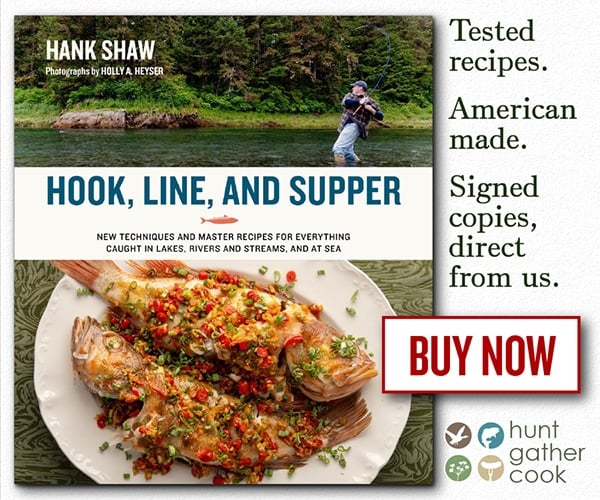



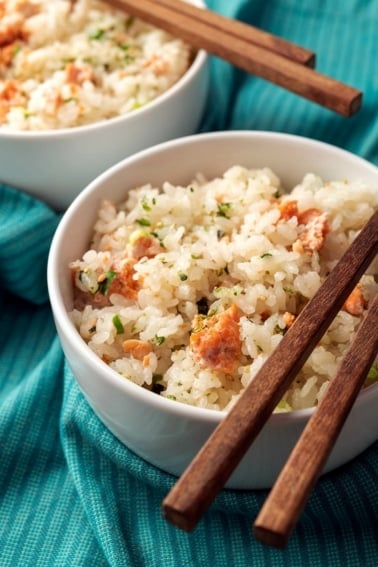
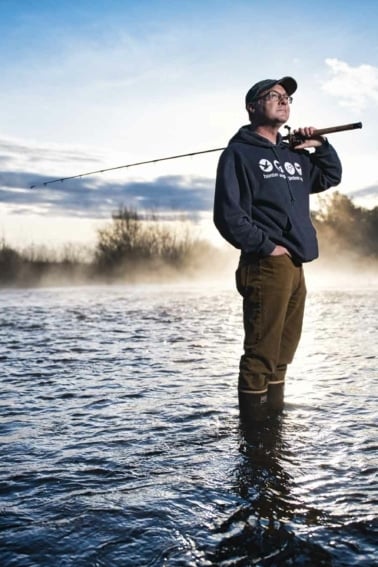
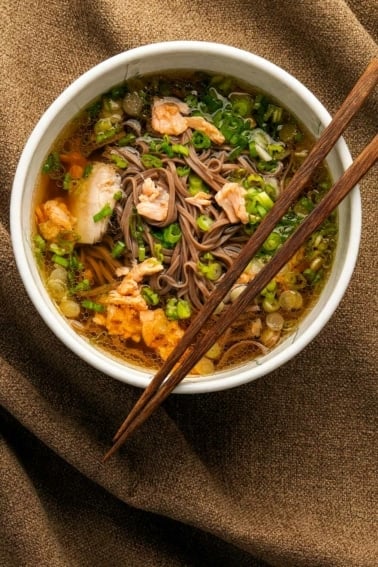
Hi Hank,
I am just about to smoke some Arctic char, and also have a Bradley smoker, but I am new to smoking, soooooo,…
My question: how many pucks do you use altogether? It’s 1 puck every 20 minutes right? but wondering, smoking even for 4 hours, with the last 2 hours w/o smoke, that means 12 pucks altogether?
Used bourbon maple glaze instead of just maple syrup but best smoked salmon I have ever had!!! Make sure to monitor temp (140 – 145) instead of time in last couple of hours and it will be the best thing you’ve ever eaten!!
Nice review Hank, lucky you have so much fresh wild salmon at your disposal. Over here in the UK wild salmon is at a premium so untouchable for me, so have to settle for farmed Atlantic. I cheat with mine to cut down on cooking time, but not in flavour. I use the dry curing method which I find better than wet cure, sea salt with a third demerara sugar. For my side of salmon cure for five hours, sprinkle cure more on thicker end reducing as you near tail end. Wash and pat dry, place on wire rack in fridge. Also to assist the forming of the pellicle if I’m in a hurry I use my wife’s hairdryer on the cold setting for a few minutes. Now I cold smoke (not letting my smoker go much over 68 degrees Fahrenheit) for about four and half hours. For you over that side of the pond it would be difficult to keep the smoker down to that temperature. I leave in smoker for another two to three hours with no smoke, just to take in the flavour of the residual smoke. Then I paint with maple syrup and grill till internal temperature reaches 145 F. Never had a failure and mates rave about the product.
I made this recipe and it was AMAZING!
First Timer. Thanks for the recipie. Clarified a lot of questions I had.
Of course next time ill start the brine earlier the day before cause I’m now finishing at 1:00am. Lol oh well it was worth it
Thanks for the recipe, Hank! In the process of smoking about 20 pounds of Lake Ontario king salmon! I’ll let everyone know how it turns out! 🙂
Jan: No. Cedar planking is more of a fresh cooking technique than smoking. Think of it as Pacific Northwest BBQ.
We are attempting salmon for the first time this weekend. We have heard that you need to put the salmon on a cedar plank while smoking it. Do you do this?
I have never smoked salmon before. I have eaten a lot of it but I have to say this was the best I’ve ever eaten!! I have an electric smoker which may have made it easier, but this was amazing! I cant stop eating it! Thank you so much!!
Brilliant recipe, just pulled the salmon out of the Bradley a while ago and had first crack. Beautiful. I used maple and alder to smoke and it is mean!! Never brined before (have only just invested in the Bradley) and it worked perfectly. I added some bay leaves to the brine and think next time ill start to get a bit more creative. Thanks for the recipie, a beauty.
Great recipe. I’m familiar with Birch Syrup but it’s not readily available. So I tried to be trendy and use Agave Nectar (the same plant that gives us tequila) as a substitute. It works!!
I recently was in Haines, AK and purchased some Strawberry Syrup and will try to use it with my next smoking.
By the way I live in the SF Bay Area and agree the last year was great for King Salmon fishing. I only hope this year will be as good.
Thanks I’ll give it a try
Mark Richard: Yes, it’ll work. Heat everything first so it all melds together, then let it cool before brining. As for a ratio, whatever you want. It should taste sweet and salty at the same time.
Hi Hank,
First of all, thanks for the quick response to my earlier question. I *love* a recipe/method that, if you follow it exactly, comes out perfectly. Yours is just that way. Made it today and it came out great. I just got a 4-rack Bradley digital–unfortunately it only goes down to 120º, so I had to do a lot of hands-on temp management (opening the door to cool it off). This is as good as the best smoked salmon I’ve ever had–I’m in the Pacific Northwest, so I get a lot of it. Never buying it again! My package of birch syrup lands here today (made my first batch with maple). Those are some nice folks up there in Alaska–thanks for turning me on to them.
hi someone has givin me some skinned sockeye salmon to smoke.Would I smoke it on tinfoil to act as a barrier like the skin would to stop drying out. I have done your maple syrup recipie with skin on and it was absolutely gorgeous
If your using a Big Green Egg, adjust your dampers. I have one and I can easily get it down to 120 to 130 degrees. But my experience is whatever a recipe says online, and your using an Egg, take off about another 20% in temperature because the egg loses little temp. Get a digital thermometer
Trent, I have started using a Little Chief again after many years away from it. I am in Florida so mullet, bluefish, mackarel, etc are the fish I normally do. The Salmon is so thick I was not sure if my Little Chief would work but it appears you have no problem with it at all. Are you just putting salt and sugar on it and not soaking it in brine?
With regards to have smoke in the smoker at all times.You don’t have to do that.the salmon has the ability to absorb only so much smoke flavour.I have a little chief smoker that has been going for almost 25 years.I do about 100 pounds of fish each year bing that I live on the water in British Columbia.Salmon capital of the world.I just sprinkle rock salt and some sugar on the fish in a flat pan.put it in the ridge overnight and smoke it for bout 8hours.the salt is the preserver and the smoke is for flavour.you can add anything you want to the salt and sugar.like garlic herbs or soy sauce.mmmmmm
Great recipe Thanks!
I worked well with halibut as well. Next I am going to try whitefish and northern pike as well. Have to wait for the weather as it -30 up here in Canada. My Bradley has trouble keeping the temp up at times. Thanks again What a great web site.
Jason,
I am just starting the smoke with a Traeger Texas; how did your’s turn out? What settings — temp / time — did you use? I have the digital thermo, so started on ‘smoke’ which seems to be 120 degrees.